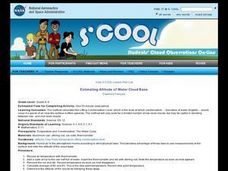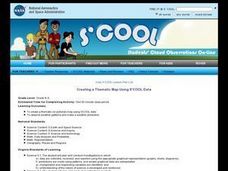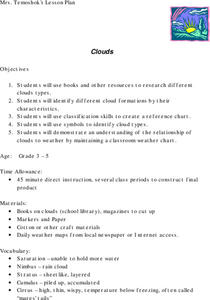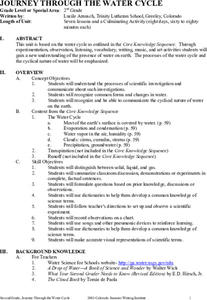Curated OER
Aruba Cloud Cover Measured by Satellite
Students analyze cloud cover over Aruba. They compose and submit written conclusions which include data, analysis, errors in data collection, and references.
Curated OER
The Sky and the Dichotomous Key
Students conduct observations and use a dichotomous key to identify clouds they see.
Curated OER
What is a Cloud
Third graders study clouds and how they are formed. They write acrostic poems about clouds and analyze and graph temperature data collected during varying degrees of cloud cover.
Curated OER
Estimating Altitude of Water Cloud Base
Students conduct an experiment to determine dew point and use a formula to detemine altitude. They construct a chart and predict what altitude clouds would form, given the dew point on the ground.
Curated OER
Creating a Thematic Map Using S'COOL Data
Learners observe weather patterns, collect data, and make a weather predictions for various locations on a map.
Curated OER
Cloud Observation and Graphing
Students identify the three major cloud groups. They are introduced to the three main cloud types and spend a week making and recording observations of clouds. Students produce a graph that presents their findings and conduct research...
Curated OER
Cloud Shadows
Students classify clouds as transparent, translucent or opaque. They conduct an experiment to determine the visual opacity of several classroom objects and then conduct further observations of clouds.
Curated OER
Poetry in Weather
Young scholars observe and identify the various types of clouds. They compare clouds to clouds on a chart, and in small groups compose and present a group poem about clouds and weather.
Curated OER
Piece of the Sky: Introduction for Making S'COOL Observations
Students observe and discuss cloud cover. They identify percent of cloud cover, calculate cloud cover by fraction and convert to a percent, and compare their models with the current real sky cloud cover.
Curated OER
Create a Cloud in a Bottle
Students observe an experiment showing the formation of a cloud. They write a paragraph summarizing the condition that are necessary for a cloud to form and explain the weather situations cause cloud formation.
Curated OER
Cloud Discovery
Young scholars create a slideshow that pictorially depicts a variety of cloud types. They research clouds, develop and present the slideshow and then evaluate their efforts based on a rubric for self-evaluation.
Curated OER
Clouds
Students discover how clouds form. They use the internet to read about the formation of clouds. They work together in groups to create their own clouds. They identify and label the four cloud types.
Curated OER
Life Lessons: Imagination
Students look at clouds and find some that are shaped like various items. They also pretend they are animals and make movements and sounds to resemble the animals.
Curated OER
How Much Water is in That Cloud?
Students participate in a demonstration about the water capacity of clouds. They work in partners to estimate how many drops of water a cottonball hold and then use an eyedropper to test their guesses.
Curated OER
Learning Lesson: Head in the Clouds
Learners observe and describe the sky as they discover the different cloud types. They record the types of clouds they see twice a day. They also use the internet to view a skywatcher chart. They end the lesson by discussing foggy...
Curated OER
Scientific Literacy - Lightning
Students investigate how radar can be used to determine the lightning potential of a cloud. Several readings are provided about the research conducted by Dr. Rob Cifelli. The scientific material is summarized in this lesson.
Curated OER
Clouds
Students explore the characteristics of clouds, their formation, symbols used in their identification, and the relationship of clouds to weather. The lesson focuses on how they are formed and their classification.
Curated OER
Cloud Formation
Learners engage in a lab which reinforces the concepts of condensation, dew point, humidity, pressure, and the process of cloud formation. After the lab, students answer questions about cloud formation imbedded in the plan.
Curated OER
Journey Through the Water Cycle
Students canvass the water cycle in the seven lessons of this unit. The processes of the water cycle and the cyclical nature of water is emphasized inthis unit.
Curated OER
Meteorologists
Fourth graders investigate the work of a meteorologist and then take on the identity of one to make reports on clouds and temperature.
Curated OER
Careers and Weather
Learners explore how weather affects a variety of jobs. Through a series of activity sheets, they determine what occupations create more or less activity because of weather conditions.
Curated OER
Clouds and Solar Radiation
Learners use satellite imaging and Mesonet solar radiation maps to answer questions given to them by the teacher and look for differences and similiarities in the data.
Curated OER
Cloud Shadows
Students classify the visual opacity of various materials, what is needed to create shadows, and classify clouds by the types of shadows that they produce.
Curated OER
Poetry in Weather
Students identify various types of clouds and write poetry about the weather.

























